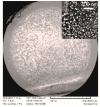Optical fiber sensor based on localized surface plasmon resonance using silver nanoparticles photodeposited on the optical fiber end
- PMID: 25302813
- PMCID: PMC4239935
- DOI: 10.3390/s141018701
Optical fiber sensor based on localized surface plasmon resonance using silver nanoparticles photodeposited on the optical fiber end
Abstract
This paper reports the implementation of an optical fiber sensor to measure the refractive index in aqueous media based on localized surface plasmon resonance (LSPR). We have used a novel technique known as photodeposition to immobilize silver nanoparticles on the optical fiber end. This technique has a simple instrumentation, involves laser light via an optical fiber and silver nanoparticles suspended in an aqueous medium. The optical sensor was assembled using a tungsten lamp as white light, a spectrometer, and an optical fiber with silver nanoparticles. The response of this sensor is such that the LSPR peak wavelength is linearly shifted to longer wavelengths as the refractive index is increased, showing a sensitivity of 67.6 nm/RIU. Experimental results are presented.
Figures






References
-
- Homola J. Surface Plasmon Resonance Based Sensors. Springer Science & Business Media; Berlin, Germany: 2006.
-
- Anker J.N., Hall W.P., Lyandres O., Shah N.C., Zhao J., van Duyne R.P. Biosensing with plasmonic nanosensors. Nat. Mater. 2008;7:442–453. - PubMed
-
- Shankaran D.R., Gobi K.V., Miura N. Recent advancements in surface plasmon resonance immunesensors for detection of small molecules of biomedical, food and environmental interest. Sens. Actuators B Chem. 2007;121:158–177.
-
- Homola J., Yee S.S., Gauglitz G. Surface plasmon resonance sensors: Review. Sens. Actuators B Chem. 1999;54:3–15.
Publication types
LinkOut - more resources
Full Text Sources
Other Literature Sources

